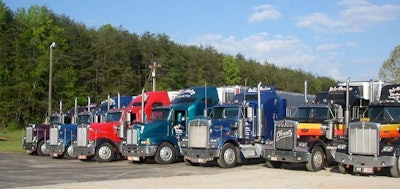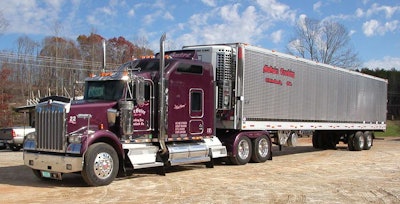Today, a couple of recommended reads out on the web — and remembering a fleet with one of our Reader Rigs gallery contributors.
Trevor Westmoreland uploaded the following two shots of the erstwhile McGuire Trucking of Cleveland, Ga., whose federal authority filing was under owner Wayne McGuire’s name. McGuire passed late last year, and, says Westmoreland, the company ceased operations in January early this year.
 “This is a picture was taken a few years back of the former fleet of McGuire Trucking,” Westmoreland wrote. “McGuire Trucking was in business from the early 80s through January of 2015. Wayne McGuire was the owner of these trucks. He is greatly missed. He always ran beautiful Kenworth trucks, many of which he bought new.”
“This is a picture was taken a few years back of the former fleet of McGuire Trucking,” Westmoreland wrote. “McGuire Trucking was in business from the early 80s through January of 2015. Wayne McGuire was the owner of these trucks. He is greatly missed. He always ran beautiful Kenworth trucks, many of which he bought new.” A 2003 Kenworth W900B in the McGuire, the truck purchased new originally.
A 2003 Kenworth W900B in the McGuire, the truck purchased new originally.Thanks for sending these in, Trevor. A fine-looking fleet. Anybody recognize any of the trucks?
A $4 billion bridge replacement that could have gone a much different way
[gtblockquote quote_text_size=”14″]”In 2012, after more than 30 years of planning and more than 400 public meetings and $100 million spent on studies, Governor Andrew Cuomo finalized the state’s plans to replace the Tappan Zee. Cuomo also decided to abandon the idea of building a rail line along the bridge, but by that time it was too late to save one of the nation’s most important infrastructure projects.” –From Philip Plotch writing in his “Lessons from the Tappan Zee Bridge” story in The Atlantic, one of costly delays, historical missteps driven by greed and more that ultimately tells a powerful story about “the need for a new approach to American infrastructure” that emphasizes maintenance and state-to-state collaboration and de-emphasizes politics.
Read the full story at this link.
Lessons for the CSA Safety Measurement System?
[gtblockquote quote_text_size=”14″]“[A]n algorithm is only as good as the data it works with.” –From a California Law Review story by Solon Barocas and Andrew Selbst quoted by Lauren Kirchner in her “When discrimination is baked into algorithms” piece, also in the Atlantic.
The story’s concerned primarily with the legal “disparate impact” theory and how it’s come to be of assistance in discrimination litigation, and how it might be applicable in the case of algorithmic targeting of consumers of all types — for instance, Kirchner offers, “What about when big data is used to determine a person’s credit score, ability to get hired, or even the length of a prison sentence?”
Bias in the results is what disparate impact would theoretically be out to show, though there’s little case history relative to discrimination at this point.
I couldn’t, of course, help but think of the CSA Safety Measurement System and its reliance on a bevy of violations issued without any court procedure whatsoever — too often, as the inspection process goes, unless there’s data to overturn a violation and carriers small and large can utilize the DataQs process for a challenge, there is nothing even to take to court as an individual matter. Drivers and carriers then are just on the other side of the whims of an algorithmic system based on an officer’s observations checked off on an inspection report. Minus any challenge, drivers and carriers merely accept guilt as the system takes the violation, converts it to a number and issues a score.
And though I know there are a multitude of varying perspectives (some negative, some positive) on what the CSA program is doing for or to the industry and/or where its utility for drivers might truly lie, I find it difficult to accept that some still fail to see just what the uproar over CSA has been these last years. The CLR writers above put it fairly succinctly.
A reader in the past put the point another way, even more succinctly: “The system has always been and is still the same… . garbage in, garbage out.”










